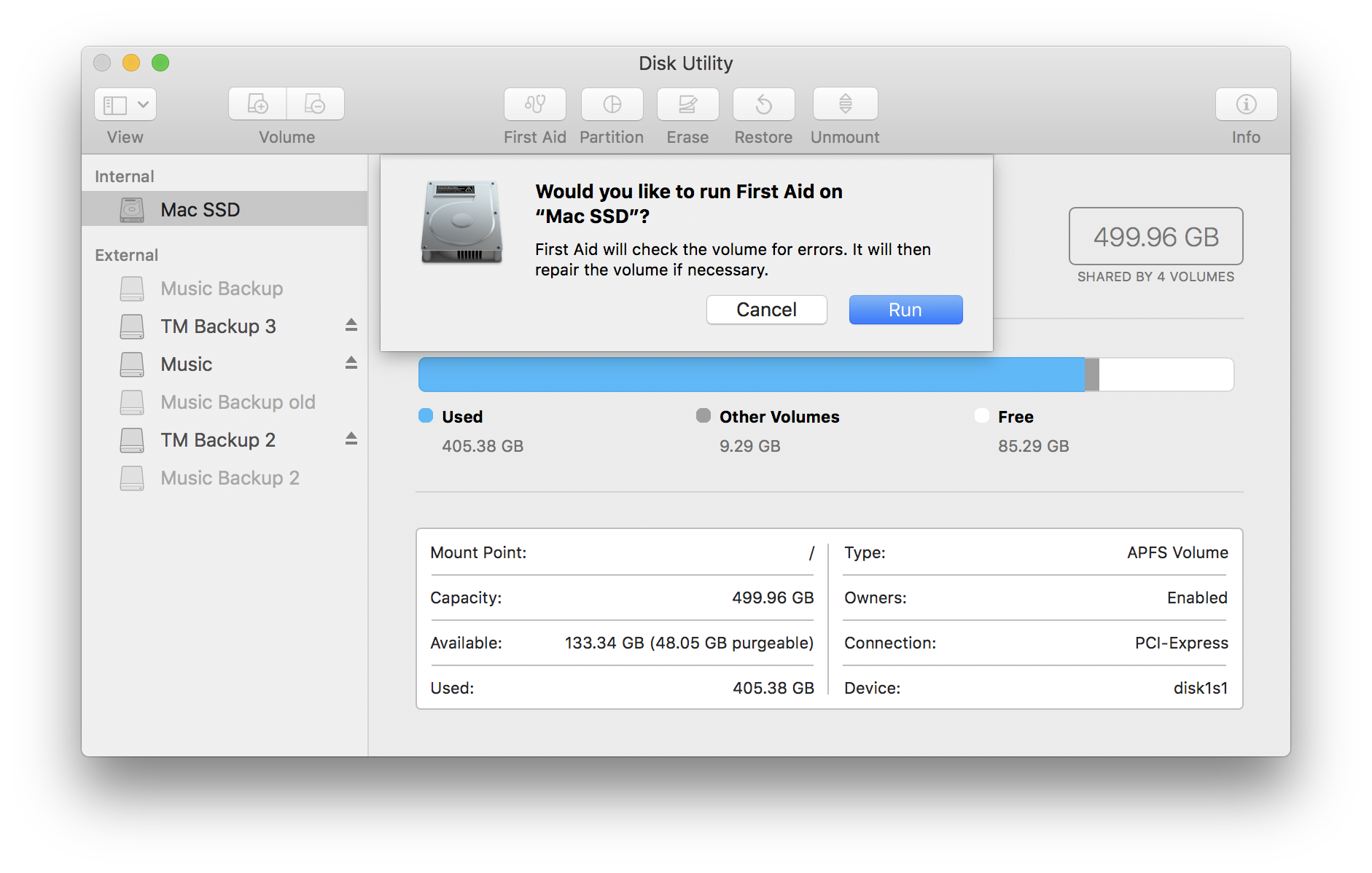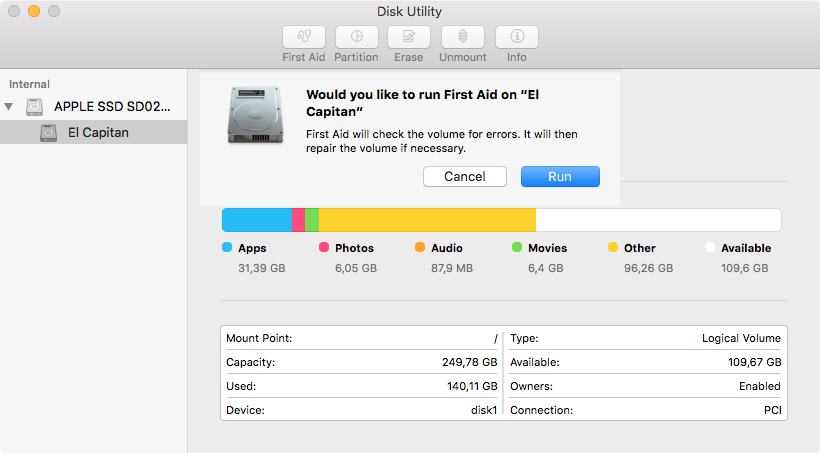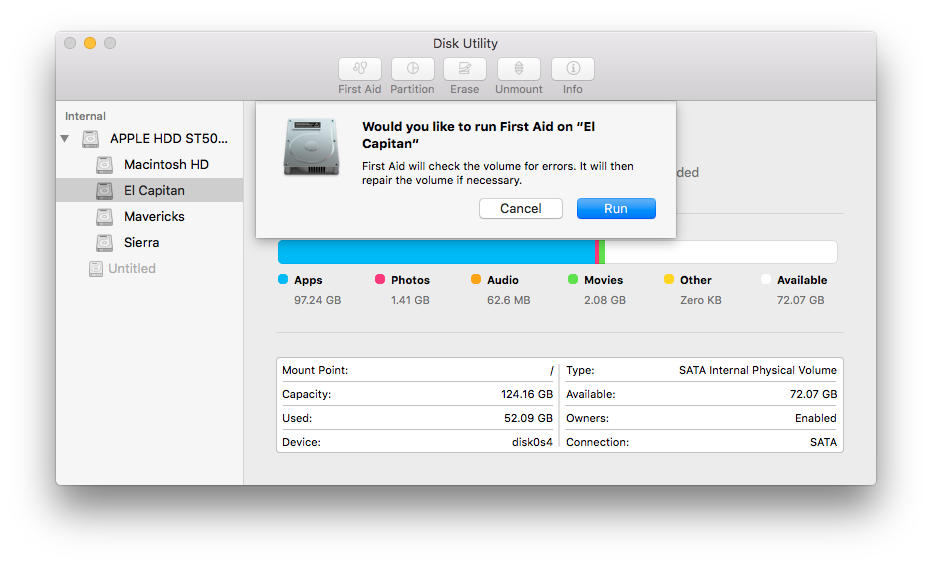Mac First Aid Disk Utility Can't Download
'file system check exit code is 8' indicates a corrupt file system was found during a check, it is caused by a sudden power failure, virus attack, catalog file corruption, invalid volume header and much more. Therefore, try to solve 'file system check exit code is 8' by following solutions.
Solutions to fix 'file system check exit code is 8' on your Mac
To use the First Aid tool on Mac, press the Command + Space key combination to launch Search and type “Disk Utility” in the search box and hit Enter. Navigate to Applications Utilities folder and then select the “Disk Utility” shortcut from the left menu pane. If you have problems with your disk, use Disk Utility on your Mac to test and repair it. Global Nav Open Menu Global Nav Close Menu. If you run First Aid on a disk, Disk Utility checks the partition maps on the disk and performs some additional checks, and then checks each volume. If Disk Utility can’t repair your disk, or you receive.
Solution 1: Run First Aid in macOS Recovery mode
First Aid is a utility built-in the Macintosh operating system for checking and repairing file system errors on Mactintosh HD, external hard drive, flash drive, SD card, memory card, USB drive, etc,.
Step 1: Turn on Mac computer by pressing Power button.
Step 2: Press and hold Command+R keys immediately upon hearing the startup chime. Hold the keys until you see the Apple logo or a spinning globe.
Step 3: Select Disk Utility from macOS Utilities in Mac recovery mode.
Step 4: Select the corrupted drive from the left panel of Disk Utility.
Step 5: Click 'First Aid' button on the top of Disk Utility window.
Step 6: Click 'Run' button to start the repair on the specific drive.
If First Aid fails to repair unreadable disk, go to solution 2 to recover data from the corrupted drive.
Solution 2: Data recovery
As a professional Mac data recovery software, M3 Data Recovery for Mac can recover deleted files emptied from Trash, recover lost data from formatted drive, recover lost data from unreadable drive, recover lost data from unmounted drive, recover lost data from corrupted drive, recover lost data from deleted/lost APFS partition, recover lost data from encrypted APFS drive, etc. on macOS Catalina 10.15/Mojave 10.14/10.13/10.12 and Mac OS X 10.11/10.10/10.9/10.8.
Step 1: Download, install and launch M3 Data Recovery for Mac on your Mac.
Step 2: Select the corrupted drive.
Step 3: M3 Data Recovery for Mac software is scanning the data from the corrupted drive.
Step 4: After the scan completes, please check/preview the found files, then select the found files you expect to recover and then click Recover to save them.
Solution 3: Erase the drive
After data recovery is successfully done from the corrupted drive, you can erase the corrupted drive to fix 'file system check exit code is 8' error on macOS Catalina 10.15/Mojave 10.14/High Sierra 10.13/Sierra 10.12 and Mac OS X 10.11/10.10/10.9/10.8 with the following steps:
Step 1: Open Applications folder -> Utilities -> Disk Utility.
Step 2: Click the icon for the corrupted drive on the left sidebar of Disk Utility.
Step 3: Click the Erase button at the top of the Disk Utility.
Step 4: Enter the name, select file system and then click the Erase button, Disk Utility will start erasing the drive. After completing to erase the corrupted drive, 'file system check exit code is 8' error will be fixed.
Sep 08, 2020 • Filed to: Answer Hard Drive Problems • Proven solutions
Disk Utility is one of the most resourceful utility tools in Mac that offers tons of features. Whenever there is an issue with Mac’s hard drive, users take the assistance of its “First Aid” feature. Surprisingly, there are times when it doesn’t seem to work and displays the “Disk Utility can’t repair the disk” error instead. While it might seem a bit complicated at first, you can easily fix the Disk Utility first aid failed error in no time. This guide will explain the same in a step by step user-friendly manner.
- Part 1: Why Disk Utility Fails to Repair a Disk
- Part 2: Steps to Fix the “Disk Utility Can’t Repair This Disk” Error
- Part 3: How to Recover Data After Mac Disk Repair
- Part 4: Tips for Using Disk Utility and Mac Hard Drive
Part1: Why Disk Utility Fails to Repair a Disk
Before we get into the details and learn ways to fix Disk Utility can’t repair the disk, let’s quickly know what Disk Utility is all about and the common reasons for this error.
What Is Disk Utility?
Disk Utility is an inbuilt utility application in Mac that helps us manage its internal or external hard drive. Ideally, Disk Utility can help you create or merge partitions, erase a hard drive, unmount it, and even repair it. The “First Aid” option is one of the most widely used features of Disk Utility. It can be used to fix various kinds of issues related to a hard drive without undergoing any data loss.
Main causes of the Disk Utility error
There are times when the Disk Utility first aid feature is failed. Ideally, it can happen due to the following reasons:
- The firmware could be corrupted, leading to the Disk Utility issue.
- Chances are that your hard drive could be damaged beyond the scope of repair.
- You might be running an outdated version of macOS.
- The disk could be removed while performing the first air operation.
- The data in the disk could be corrupted.
- The disk might have a bad sector or could be corrupted by a malware
Part 2: Steps to Fix the “Disk Utility Can’t Repair This Disk” Error
Ideally, it doesn’t take a lot of effort to fix the Disk Utility can’t repair the disk issue. Firstly, you need to back up the existing data on the disk as it might stop functioning anytime. Once it is done, you can reformat the disk or fix the root issue behind it. In the end, you can restore the backup data and start using your Mac the usual way. Here’s a stepwise solution to fix Disk Utility first aid failed issue like a pro.
Step 1: Backup your Disk’s Content
When we get the Disk Utility can’t repair this disk prompt, it is recommended to take a backup of our data first. Mostly, the error depicts that the disk is not stable and can get corrupt anytime. Therefore, if you don’t want to suffer from an unwanted loss of your files, then consider taking a dedicated backup.
To do this, you can use an external hard drive and simply copy-and-paste your files on it. Besides that, you can also take the assistance of a Time Machine for a smoother process.
1. Firstly, connect your external drive to your Mac using a working cable. As soon as it gets detected by it, Time Machine will automatically display the following prompt. Just select the “Use as Backup Disk” feature to proceed.
2. In case you don’t get this prompt, then you can manually launch the Time Machine tool from Mac’s System Preferences.
3. Now, just select the backup disk and start the process. Wait for a while as Time Machine would take a dedicated backup of your disk on the external drive. Just make sure that the external drive has enough free storage in advance.
Step 2: Fix the Disk Utility Error
Great! Once you have taken a backup of your important files, you can easily fix the Disk Utility first aid failed error. The following are some of the major solutions to this.
Fix 1: Use the FSCK command
FSCK is an inbuilt command in Mac that can help us manually repair a disk. Though, to run it, you need to first boot your system in a single user mode. Later, you can follow these basic steps to fix Disk Utility can’t repair the disk error.
1. Restart your Mac and hold the Command + S keys for a few seconds while it boots. This will automatically boot it in a single user mode.
2. Once the terminal window of the single user mode is launched, you can just type the command “/sbin/fsck –fy”. This is a disk repair and diagnostic command that will scan the disk and would try to fix it automatically.
3. Since the disk would be read-only in the single-user mode, you need to change that first. To do this, you need to type the command “/sbin/mount -uw /” and press enter.
4. If everything goes well, then you will get the “The volume Macintosh HD appears to be OK' prompt. If not, then enter the “fsck –fy” command a few times till you get this expected message.

5. That’s it! Once the Macintosh HD is fixed, you can enter the “reboot” command to restart your system in the normal mode.
Fix 2: Format the Disk
If the FSCK command is not able to fix the Disk Utility first aid failed problem, then you can also format the disk. Needless to say, this will erase all the existing data from the disk and will also get rid of any malicious entity from it. To do this, you can also take the assistance of Mac’s Disk Utility.
1. Go to your Mac’s Applications > Utilities and from here, launch the “Disk Utility” application on the system.
2. As the Disk Utility window will open, you can view the Macintosh HD and the available partitions (or the external sources). Simply select the disk that you wish to format.
3. Now, click on the “Erase” button on the right and confirm your choice when the following pop-up would appear. You can also select the file format and partition scheme of the disk from here.
4. Click on the “Erase” button again and wait as the disk would be formatted. Later, you can restart your Mac and try to access the disk again.
Step 3: Recover your backup
Once you have fixed the Disk Utility can’t repair the disk issue, you can recover your data. If you have formatted the disk, then all the existing data on it would be lost. The good thing is that you have already maintained a backup of your disk on Time Machine. Now, you can again take its assistance to restore your backup.
1. To begin with, connect your Time Machine disk to Mac and launch the Time Machine application from System Preferences.
2. The Time Machine drive will open for you to browse. Use the arrow keys on the side to browse the backup files.
3. Once you find the data you are looking for, just click on the “Restore” button to save it to its original location.
In case if you have not maintained a prior backup of your data, then you can use a recovery tool. For instance, with the help of Recoverit Data Recovery, you can get back the content from a formatted hard drive. We have explored this solution in the next section.
Part 3: How to Recover Data After Mac Disk Repair
A lot of times, when users get the “Disk Utility can’t repair this disk” error, then simply format the drive without taking its backup. In this case, you can take the assistance of Recoverit Data Recovery. Developed by Wondershare, it is one of the most reliable data recovery tools for Mac. It doesn’t matter what kind of data you have lost and under which scenario, Recoverit will fix it all. This even includes recovering data from a formatted hard drive, corrupt storage, Trash deletion, accidental deletion, and so on.
Step 1: Select a source to scan
Install and launch Wondershare Recoverit Data Recovery on your Mac as soon as you suffer from any unwanted data loss. On the home page of Recoverit, you can see various locations like hard drive, partitions, folders, etc. Just select the formatted hard drive and click on the “Start” button.
Step 2: Scan the source
Sit back and wait for a few minutes for Recoverit to extract all kinds of lost content from the hard drive. It might take a while for the process to be completed. Though, you can pause the process in between if you want to.
Step 3: Restore your data
Mac First Aid Disk Utility Can't Download Torrent
Once the process is over, all the extracted files will be listed under different categories for you to preview. You can preview the extracted photos, videos, and even documents. Select the files of your choice and click on the “Recover” button to save them.
Part 4: Tips for Using Disk Utility and Mac Hard Drive
By now, you would be able to fix the Disk Utility first aid failed issue like a pro. If you don’t want to go through a similar situation again, then consider following these tips.
- Keep your Mac updated
If your system is running on an old or outdated version of macOS, then it might cause issues like Disk Utility can’t repair the disk. To avoid this, simply go to your Mac’s settings and check for updates. An upgraded system will have fewer chances of encountering these issues.
- Check your hard disk’s health regularly

Most of the Mac users only use the First Aid feature of Disk Utility to fix their hard drives. Ideally, it is recommended to use this feature every once in a while. This will help you diagnose the overall health of the hard drive and you can take preventive measures beforehand.
- Keep enough disk space empty
Mac users often suffer from limited free space on their hard drives. If the disk is packed and does not have enough free space, then it might cause more problems to your system. Therefore, make sure that at least 20% of the hard disk remains empty at any cost.
- Manage partitions efficiently
Disk Utility also makes it easier for us to create, delete, and merge partitions. Ideally, you can keep the firmware and the user data in different partitions to make sure that you can manage your partitions more efficiently.
- Avoid using third-party disk management tools
There are all kinds of third-party tools out there for macOS that works as a substitute to Disk Utility. While they might seem like a more convenient solution, they can cause more harm to your system than good. Carefully pick these third-party tools and only go with a reliable solution.
There you go! Now when you know how to fix the Disk Utility can’t repair this disk issue, you can easily overcome this problem. Since the solution might involve the formatting of the disk, you can consider using a recovery tool like Recoverit. Even if you have not taken a prior backup of your drive, Recoverit would let you get back the lost and formatted content from it. Since it offers a free trial, you can easily give it a shot without spending a single penny.
Mac First Aid Disk Utility
What's Wrong with Drive

Mac Disk Utility Restore
- Recover Your Drive
- Fix Your Drive
- Format/Wipe Drive
- Know Your Drive